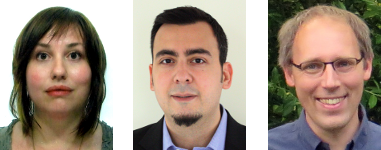Advanced atomic force microscopy II

Dr. Milica Todorovic, Aalto University, Finland
Prof. Mehmet Z. Baykara, University of California Merced, USA
PD Dr. Thilo Glatzel, University of Basel, Switzerland
In this thematic issue, we present state-of-the-art research on non-contact atomic force microscopy (nc-AFM) with a focus on high resolution, the development of advanced scanning and spectroscopy techniques, simulation and theoretical modeling of the tip–sample interactions, as well as the application of nc-AFM to new materials.
Potential contributions are expected to be focused on the following topics:
- Novel instrumentation and techniques in AFM
- Atomic-resolution imaging on insulating substrates, semiconductors, and metals
- High-resolution imaging of molecules, clusters and biological systems
- Atomic- and molecular-scale manipulation
- Simultaneous force and tunneling current spectroscopy
- High-resolution imaging and spectroscopy in liquid environments
- Theoretical analysis of contrast mechanisms, forces and tunneling phenomena
- 2D and 3D force-field mapping
- Small amplitude and lateral force measurements using dynamic methods
- Mechanisms and understanding of damping and energy dissipation
- Nanoscale measurements of charges, work function, and magnetic properties
- Theoretical aspects of scanning probe techniques
Effective sensor properties and sensitivity considerations of a dynamic co-resonantly coupled cantilever sensor
- Julia Körner
Beilstein J. Nanotechnol. 2018, 9, 2546–2560, doi:10.3762/bjnano.9.237

Nitrous oxide as an effective AFM tip functionalization: a comparative study
- Taras Chutora,
- Bruno de la Torre,
- Pingo Mutombo,
- Jack Hellerstedt,
- Jaromír Kopeček,
- Pavel Jelínek and
- Martin Švec
Beilstein J. Nanotechnol. 2019, 10, 315–321, doi:10.3762/bjnano.10.30

Review of time-resolved non-contact electrostatic force microscopy techniques with applications to ionic transport measurements
- Aaron Mascaro,
- Yoichi Miyahara,
- Tyler Enright,
- Omur E. Dagdeviren and
- Peter Grütter
Beilstein J. Nanotechnol. 2019, 10, 617–633, doi:10.3762/bjnano.10.62

Comparing a porphyrin- and a coumarin-based dye adsorbed on NiO(001)
- Sara Freund,
- Antoine Hinaut,
- Nathalie Marinakis,
- Edwin C. Constable,
- Ernst Meyer,
- Catherine E. Housecroft and
- Thilo Glatzel
Beilstein J. Nanotechnol. 2019, 10, 874–881, doi:10.3762/bjnano.10.88

Influence of dielectric layer thickness and roughness on topographic effects in magnetic force microscopy
- Alexander Krivcov,
- Jasmin Ehrler,
- Marc Fuhrmann,
- Tanja Junkers and
- Hildegard Möbius
Beilstein J. Nanotechnol. 2019, 10, 1056–1064, doi:10.3762/bjnano.10.106

Kelvin probe force microscopy work function characterization of transition metal oxide crystals under ongoing reduction and oxidation
- Dominik Wrana,
- Karol Cieślik,
- Wojciech Belza,
- Christian Rodenbücher,
- Krzysztof Szot and
- Franciszek Krok
Beilstein J. Nanotechnol. 2019, 10, 1596–1607, doi:10.3762/bjnano.10.155

Ion mobility and material transport on KBr in air as a function of the relative humidity
- Dominik J. Kirpal,
- Korbinian Pürckhauer,
- Alfred J. Weymouth and
- Franz J. Giessibl
Beilstein J. Nanotechnol. 2019, 10, 2084–2093, doi:10.3762/bjnano.10.203

Integration of sharp silicon nitride tips into high-speed SU8 cantilevers in a batch fabrication process
- Nahid Hosseini,
- Matthias Neuenschwander,
- Oliver Peric,
- Santiago H. Andany,
- Jonathan D. Adams and
- Georg E. Fantner
Beilstein J. Nanotechnol. 2019, 10, 2357–2363, doi:10.3762/bjnano.10.226

A review of demodulation techniques for multifrequency atomic force microscopy
- David M. Harcombe,
- Michael G. Ruppert and
- Andrew J. Fleming
Beilstein J. Nanotechnol. 2020, 11, 76–91, doi:10.3762/bjnano.11.8

Implementation of data-cube pump–probe KPFM on organic solar cells
- Benjamin Grévin,
- Olivier Bardagot and
- Renaud Demadrille
Beilstein J. Nanotechnol. 2020, 11, 323–337, doi:10.3762/bjnano.11.24

Atomic-resolution imaging of rutile TiO2(110)-(1 × 2) reconstructed surface by non-contact atomic force microscopy
- Daiki Katsube,
- Shoki Ojima,
- Eiichi Inami and
- Masayuki Abe
Beilstein J. Nanotechnol. 2020, 11, 443–449, doi:10.3762/bjnano.11.35

Current measurements in the intermittent-contact mode of atomic force microscopy using the Fourier method: a feasibility analysis
- Berkin Uluutku and
- Santiago D. Solares
Beilstein J. Nanotechnol. 2020, 11, 453–465, doi:10.3762/bjnano.11.37
































































































